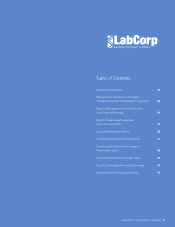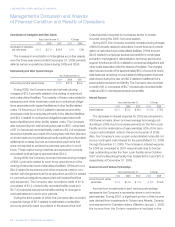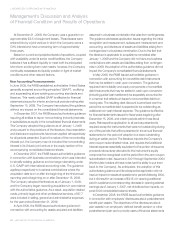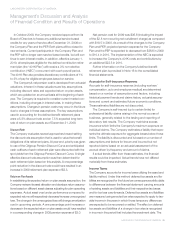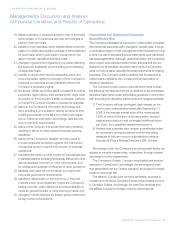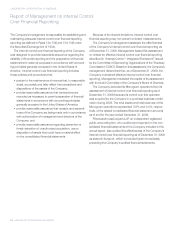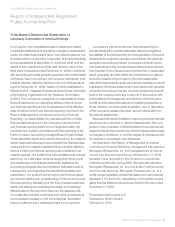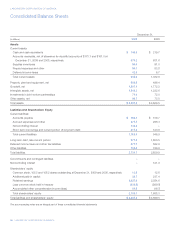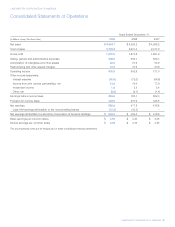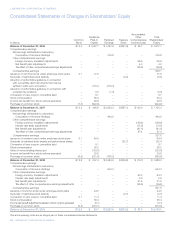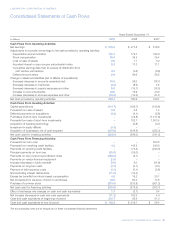LabCorp 2009 Annual Report Download - page 31
Download and view the complete annual report
Please find page 31 of the 2009 LabCorp annual report below. You can navigate through the pages in the report by either clicking on the pages listed below, or by using the keyword search tool below to find specific information within the annual report.LABORATORY CORPORATION OF AMERICA
Management’s Discussion and Analysis
of Financial Condition and Results of Operations
LABORATORY CORPORATION OF AMERICA 29
with an understanding of: (1) how investment allocation decisions
are made, including the factors that are pertinent to an under-
standing of investment policies and strategies, (2) the major
categories of plan assets, (3) the inputs and valuation tech-
niques used to measure the fair value of plan assets, (4) the
effect of fair value measurements using significant unobservable
inputs (Level 3) on changes in plan assets for the period, and
(5) significant concentrations of risk within plan assets. The
guidance is effective for years ending after December 15, 2009.
Upon initial application, the provisions of the literature are not
required for earlier periods that are presented for comparative
periods. The Company is providing the additional disclosures
in accordance with the authoritative guidance (see Note 16 to
the notes to consolidated financial statements).
In April 2009, the FASB issued authoritative guidance in
connection with determining fair value when the volume and
level of activity for an asset or liability have significantly decreased
and identifying transactions that are not orderly. The literature
provides authoritative guidance in determining whether a
market is active or inactive, and whether a transaction is dis-
tressed. The guidance is applicable to all assets and liabilities
(i.e. financial and nonfinancial) and requires enhanced disclo-
sures, including interim and annual disclosure of the input
and valuation techniques (or changes in techniques) used to
measure fair value and the defining of the major security types
comprising debt and equity securities held based upon the
nature and risk of the security. The literature is effective for
interim and annual periods ending after June 15, 2009. The
adoption of the authoritative guidance did not have a material
impact on the Company’s consolidated financial statements
and related disclosures in the notes thereto.
In May 2009, the FASB issued authoritative guidance related
to the accounting for and disclosure of subsequent events,
which is effective for interim and annual periods ending after
June 15, 2009. This new guidance establishes general stan-
dards of accounting for and disclosure of events that occur
after the balance sheet date but before financial statements
are issued or are available to be issued. This guidance intro-
duces new terminology but is based on the same principles
that previously existed in the auditing standards. Under this
new guidance, the Company is required to provide disclosure
of the date through which it has evaluated subsequent events
and whether that date represents the date the financial state-
ments were issued or the date the financial statements were
available to be issued. For the financial statements related to the
years ended December 31, 2009, 2008 and 2007 contained
herein, the Company has evaluated subsequent events through
February 24, 2010 representing the date these financial state-
ments were issued.
In June 2009, the FASB issued authoritative guidance in
connection with adding qualified special purpose entities into
the scope of guidance for consolidation of variable interest
entities. This literature also modifies the analysis by which a
controlling interest of a variable interest entity is determined
thereby requiring the controlling interest to consolidate the
variable interest entity. A controlling interest exists if a party to
a variable interest entity has both (i) the power to direct the
activities of a variable interest entity that most significantly
impact the entity’s economic performance and (ii) the obliga-
tion to absorb losses of or receive benefits from the entity that
could be potentially significant to the variable interest entity.
The guidance becomes effective as of the beginning of the first
annual reporting period beginning after November 15, 2009
and should be applied prospectively for interim and annual
periods during that period going forward. The Company is cur-
rently evaluating the impact the adoption of the authoritative
guidance could have on its consolidated financial statements.
In August 2009, the FASB issued authoritative guidance in
connection with measuring liabilities at fair value. The guidance
addresses the impact of transfer restrictions on the fair value of
a liability and the ability to use the fair value of a liability that is
traded as an asset as an input to the valuation of the underly-
ing liability. The literature also clarifies the application of certain
valuation techniques. Those clarifications include when to
make adjustments to fair value. The guidance became effec-
tive in the Company’s quarter ended December 31, 2009. The
adoption of the authoritative guidance did not have an impact
on the Company’s consolidated financial statements as of and
for the year ended December 31, 2009.
Critical Accounting Policies
The preparation of financial statements in conformity with
generally accepted accounting principles requires manage-
ment to make estimates and assumptions that affect the
reported amounts of assets and liabilities and disclosure of
contingent assets and liabilities at the date of the financial
statements and the reported amounts of revenues and
expenses during the reported periods. While management
believes these estimates are reasonable and consistent, they
are by their very nature, estimates of amounts that will depend


